Note
Go to the end to download the full example code
Plotting a solar cycle index#
This example demonstrates how to plot the solar cycle in terms of the number of sunspots and a prediction for the next few years.
import matplotlib.pyplot as plt
import astropy.units as u
from astropy.time import Time, TimeDelta
from astropy.visualization import time_support
import sunpy.timeseries as ts
from sunpy.net import Fido
from sunpy.net import attrs as a
from sunpy.time import TimeRange
The U.S. Dept. of Commerce, NOAA, Space Weather Prediction Center (SWPC) provides recent solar cycle indices which includes different sunspot numbers, radio flux, and geomagnetic index. They also provide predictions for how the sunspot number and radio flux will evolve. Predicted values are based on the consensus of the Solar Cycle 24 Prediction Panel.
We will first search for and then download the data.
time_range = TimeRange("2008-06-01 00:00", Time.now())
result = Fido.search(a.Time(time_range), a.Instrument('noaa-indices'))
f_noaa_indices = Fido.fetch(result)
result = Fido.search(a.Time(time_range.end, time_range.end + TimeDelta(4 * u.year)),
a.Instrument('noaa-predict'))
f_noaa_predict = Fido.fetch(result)
We then load them into individual TimeSeries objects.
noaa = ts.TimeSeries(f_noaa_indices, source='noaaindices').truncate(time_range)
noaa_predict = ts.TimeSeries(f_noaa_predict, source='noaapredictindices')
/home/docs/checkouts/readthedocs.org/user_builds/sunpy/conda/stable/lib/python3.10/site-packages/erfa/core.py:133: ErfaWarning: ERFA function "dtf2d" yielded 1 of "dubious year (Note 6)"
warn(f'ERFA function "{func_name}" yielded {wmsg}', ErfaWarning)
/home/docs/checkouts/readthedocs.org/user_builds/sunpy/conda/stable/lib/python3.10/site-packages/erfa/core.py:133: ErfaWarning: ERFA function "dtf2d" yielded 1 of "dubious year (Note 6)"
warn(f'ERFA function "{func_name}" yielded {wmsg}', ErfaWarning)
Finally, we plot both noaa and noaa_predict for the sunspot number.
In this case we use the S.I.D.C. Brussels International Sunspot Number (RI).
The predictions provide both a high and low values, which we plot below as
ranges.
time_support()
fig, ax = plt.subplots()
ax.plot(noaa.time, noaa.quantity('sunspot RI'), label='Sunspot Number')
ax.plot(
noaa_predict.time, noaa_predict.quantity('sunspot'),
color='grey', label='Near-term Prediction'
)
ax.fill_between(
noaa_predict.time, noaa_predict.quantity('sunspot low'),
noaa_predict.quantity('sunspot high'), alpha=0.3, color='grey'
)
ax.set_ylim(bottom=0)
ax.set_ylabel('Sunspot Number')
ax.set_xlabel('Year')
ax.legend()
plt.show()

/home/docs/checkouts/readthedocs.org/user_builds/sunpy/conda/stable/lib/python3.10/site-packages/erfa/core.py:133: ErfaWarning: ERFA function "dtf2d" yielded 144 of "dubious year (Note 6)"
warn(f'ERFA function "{func_name}" yielded {wmsg}', ErfaWarning)
Total running time of the script: (0 minutes 5.554 seconds)